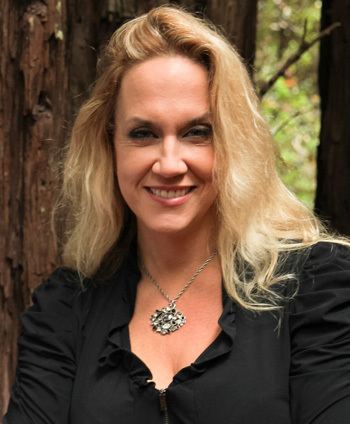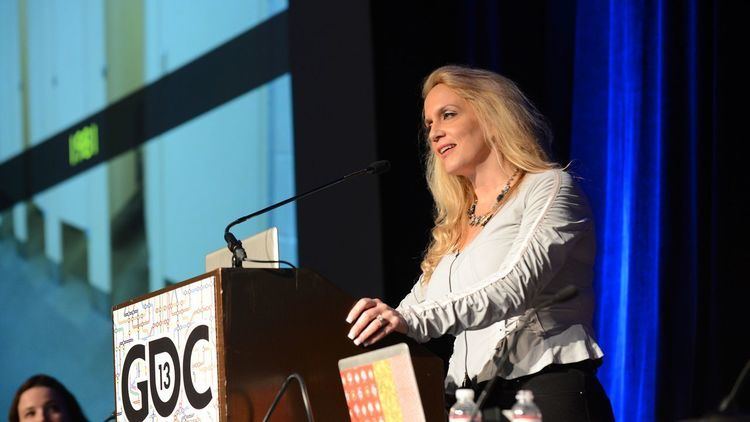Other names Brenda Brathwaite Name Brenda Romero | Occupation Video game designer Role Game designer | |
 | ||
Full Name Brenda Louise Garno Books Sex in Video Games, Challenges for Game Designers, Breaking Into the Game Ind, Sid Meier's Civilization Revolutio Similar People John Romero, Brian Ralph, Winrich Kolbe Profiles | ||
Are Games Art? | Brenda Romero | TEDxGalway
Brenda Louise Romero (nee Garno, born October 12, 1966), previously known as Brenda Brathwaite, is an American game designer and developer in the video game industry. She was born in Ogdensburg, New York and is a graduate of Clarkson University. Romero is best known for her work on the Wizardry series of role-playing video games and, more recently, the non-digital series The Mechanic is the Message. She has worked in game development since 1981 and has credits on 22 game titles.
Contents
- Are Games Art Brenda Romero TEDxGalway
- Matt chat 237 brenda romero on teaching and learning with videogames
- Career
- Personal life
- IGDA and activism
- Academics
- Mechanic is the Message
- References
For Wizardry, Romero provided game design, level design, system design, writing and scripting. She also wrote the manuals and documentation for some products in the series. Romero provided writing and documentation for the award-winning Jagged Alliance series. She also worked on other notable franchises including games such as Def Jam: Icon, Playboy: The Mansion, Dungeons & Dragons: Heroes, and others.

Matt chat 237 brenda romero on teaching and learning with videogames
Career
Romero began her career in 1981 at video game developer and publisher Sir-tech Software, Inc., on the Wizardry role-playing team. She worked first as a tester, and moved up through the design and content creation ranks to lead designer for the award-winning series. While at Sir-tech, Romero also worked on the Jagged Alliance and Realms of Arkania series. She was employed with Sir-tech for 18 years before moving on to game maker Atari where she worked on the Dungeons & Dragons series for consoles before joining Cyberlore Studios in 2003 to work on the Playboy: The Mansion game. Romero's research for the game was ultimately published in a book, Sex in Video Games.

In 2006, Romero was named one of the 100 most influential women in the game industry by Next Generation magazine and her peers. Nerve magazine cited her as a "New Radical" — one of "the 50 artists, actors, authors, activists and icons who are making the world a more stimulating place". In 2009, Next Generation magazine identified her as the woman with the longest continuous service in video game development.

Romero served as Chair of the Savannah College of Art and Design's Interactive Design and Game Development department until November 2009. She moved to San Francisco to consult as Creative Director for social media company Slide, Inc., and then became Creative Director of social gaming company Lolapps, Inc. in May 2010. She co-founded the social game company Loot Drop with John Romero in November 2010, then left Lolapps and joined Loot Drop in February 2011. In 2013, Romero became the first game designer in residence at the Games and Playable Media Program of the University of California at Santa Cruz. She also serves as the program's director.
Personal life

Romero married game developer John Romero on October 27, 2012. Together, they worked on Ravenwood Fair, with John as lead designer and Brenda as creative director and game designer. John and Brenda became engaged on March 24, 2012. Brenda has three children from a previous marriage: Maezza, born in 2001, and twins Avalon and Donovan, born in 2004.
IGDA and activism
Romero was an active member of the International Game Developers Association (IGDA). In 2008, she was elected to the IGDA's Board of Directors. On March 28, 2013, she resigned as co-chair of the IGDA Women in Games SIG in protest over an incident in which scantily-clad women performed for a party co-sponsored by IGDA and yetizen, since she felt that the performance conflicted with IGDA's support for the advancement of female game authors and designers.
She founded the International Game Developers Sex Special Interest Group (Sex SIG) in 2005. Since working on Playboy, she has studied adult and sexual content in video games and is regularly interviewed about the subject in the media. She has written a book on the subject, Sex in Video Games.
She is an anti-censorship activist and a proponent of parental rating awareness.
Academics
She is a regular speaker at universities and conferences including the Game Developers Conference, Austin Game Developers Conference, and Montreal International Games Summit. Some of her lectures have been held at the Massachusetts Institute of Technology, The Guildhall at Southern Methodist University, and Clarkson University.
In the spring of 2007, she was awarded the Presidential Fellowship at Savannah College of Art and Design to develop an exhibit and presentation titled, "What You Don't Know About Video Games...". In April 2008, Romero became Chair of the Interactive Design and Game Development department at the Savannah College of Art and Design (SCAD). Brathwaite left SCAD in November 2009 to return to full-time commercial game development.
In December 2012, she was appointed "Game Designer in Residence" at the University of California, Santa Cruz.
In March 2014, she was awarded a Fulbright Fellowship.
Mechanic is the Message
In February 2008, Romero began work on a series of non-digital games known collectively as The Mechanic is the Message. According to the series abstract,
"The Mechanic is the Message captures and expresses difficult experiences through the medium of a game. Much like photographs, paintings, literature and music are capable of transmitting the full range of the human experience from one human to another, so too can games. Due to their interactivity, the installation suggests that games are capable of a higher form of communication, one which actively engages the participant and makes them a part of the experience rather than a passive observer."
The series is composed of six separate non-digital games that experiment with the traditional notions of games.
Of the six, Train has received the most attention, and won the Vanguard Award at Indiecade in October 2009 for "pushing the boundaries of game design and showing us what games can do." Train was also featured in the Wall Street Journal as well as on game industry sites including Gamasutra where it received accolades for its ability to evoke meaning through gestures, the Escapist Magazine, Extra Credits, and on Kotaku. Romero delivered Train: How I Dumped Electricity and Learned to Love Design at the 2010 Gamesauce Conference.
Siochan leat (Irish for "peace be with you") chronicles the history of her children's heritage. Romero made the game following The New World, a game she originally made to teach her daughter about the slave trade. Romero designed Siochan leat to teach her daughter about her Irish heritage and traces the family's history from the Cromwellian invasion of Ireland to their ancestor's eventual immigration into the West Indies on the paternal side and Canada on the maternal side. The game features a burlap pillow simulating an earthen mound covered by 26 pieces of grass, each representing a county in Ireland. In a talk given at the Austin Game Developers Conference in September 2009, Romero noted that the burlap was filled with mementos of her upbringing and her heritage, including photographs of her great grandfather, Paddy Donovan, and one of her mother's rosaries. On her blog, Romero notes that "the game is signed in many ways and is highly autobiographical. It is my history and it also reveals my feelings about its present state."
